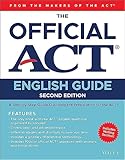The Official ACT English Guide / ACT
Publication details: Lowa Wiley 2021Edition: 2ndDescription: ix, 534 pages 26 cmISBN:- 9781119787303 (pbk)
- 428.0076
| Item type | Current library | Shelving location | Call number | Materials specified | Status | Notes | Barcode | |
|---|---|---|---|---|---|---|---|---|
 BOOKs
BOOKs
|
National Law School | General Stacks | 428.0076 ACT - 2 (Browse shelf(Opens below)) | PB | Available | Recommended by Dr. Dhivya Janarthanan | 39291 | |
 BOOKs
BOOKs
|
National Law School | General Stacks | 428.0076 ACT (Browse shelf(Opens below)) | PB | Available | Recommended by Dr. Dhivya Janarthanan | 39258 |
Browsing National Law School shelves,Shelving location: General Stacks Close shelf browser (Hides shelf browser)

|

|

|

|

|

|

|
||
| 428.00712 COX - 2 Cambridge IGCSE® First Language English Teacher's Resource with Digital Access / | 428.00712 SAA - 1 English B course companion / | 428.00712 SAA - 2 English B course companion / | 428.0076 ACT The Official ACT English Guide / | 428.0076 ACT - 2 The Official ACT English Guide / | 428.0076 ALL English A : language and literature. Course companion / | 428.0076 COX - 1 Cambridge IGCSE First Language English Coursebook / |
Introduction ix;
Chapter 1 An Overview of the ACT English and Writing Tests 1;
The Structure of the English Test 1;
Content of the ACT English Test 4;
The Content of the Writing Test 7;
How to Use This Guide 7;
Chapter 2 Taking the English Test 9;
Approaching the Questions 9;
Checking Your Answers 10;
Types of Questions 11;
Chapter 3 Conventions of Standard English: Sentence Structure, Formation, and Usage 37;
Sentence Structure 38;
Verbs and Verb Phrases 38;
Indefinite Pronouns 41;
Collective Nouns 42;
Relative Clauses 42;
Using the Relative Pronoun “Which” 43;
Which versus That 44;
Chapter 4 Conventions of Standard English Concepts and Sample Questions: Sentence Structure and Usage 47;
Parallel Structure 48;
Correlative Conjunctions 52;
Pronouns and Antecedents 53;
Sentence Fragments 58;
Who versus Whom 61;
Run-on, or Fused, Sentences 64;
Modifiers 66;
Subject-Verb Agreement 80;
Verb Tense 84;
Chapter 5 Conventions of Standard English and Sample Questions: Punctuation 99;
Commas 100;
Dashes 120;
Parentheses 121;
Colons 124;
Semicolons 126;
Apostrophes and Possession 128;
Chapter 6 Production of Writing 135;
Topic Development 135;
Transitions between Sentences 136;
Transitions between Paragraphs 144;
Paragraph Placement 149;
Conclusion Questions 153;
Chapter 7 Knowledge of Language 171;
Redundancy 171;
Wordiness 178;
Word Choice 181;
Developing an Ear for Collocations 184;
Chapter 8 An Overview of the ACT Writing Test 187;
Subject Matter 189;
Scoring 190;
The Scoring Rubric 190;
Chapter 9 The Setup of the Writing Test 193;
Introductory Paragraph in the Prompt 195;
Perspectives in the Prompt 195;
Essay Task Box 196;
Planning Page 196;
Directions 199;
Chapter 10 The Essay Structure 205;
Organization 205;
Addressing the Counterargument 208;
Knowing What is Expected for the Rubric Categories 210;
Chapter 11 Writing Your Essay 213;
Purpose and Point of View 215;
Intended Audience and Tone 217;
Prewriting 217;
Timing During the Actual Test 219;
Revising 220;
Basic Strategies for Improving Your Writing 221;
Revising Your First Drafts 222;
Chapter 12 Strengthen Your Essay with Vocabulary, Writing Mechanics, and Other Strategies 223;
Vocabulary 224;
Varied Sentence Structures and Punctuation 224;
Rhetorical Questions 224;
Avoiding Simplistic Thinking 225;
Brainstorming about Your Values 225;
Building Your Fund of Knowledge 226;
Avoid What You Don’t Know 227;
Chapter 13 Sample Prompts and Essays with Analysis 229;
Writing Test: Innovation 230;
Writing Test: Students and Sleep 241;
Chapter 14 Practice Questions 261;
Chapter 15 Answers and Explanations 337;
Answer Key 338;
Explanatory Answers 340;
Appendix: English Test Glossary 529.
There are no comments on this title.
